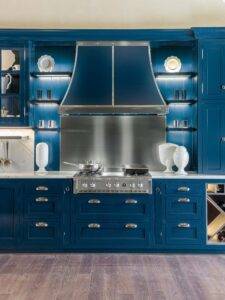The Essence of Italian Kitchen Design: where Culture meets Innovation
Italian kitchen design isn’t merely about aesthetics and functionality; it’s a manifestation of a rich culinary heritage and a lifestyle steeped in tradition and innovation. Beyond the sleek surfaces and minimalist decor, Italian kitchens reflect a world of cultural nuances and culinary customs that profoundly influence their design. Let’s embark on a journey to explore the lesser-known aspects of Italian kitchen culture that inspire and shape these iconic spaces.
At the core of Italian cuisine lies the concept of “cucina povera,” or peasant cooking. This culinary philosophy champions the use of simple, locally sourced ingredients to create flavorful and wholesome meals. Italian kitchen design echoes this ethos through the use of natural materials like wood and stone, as well as a commitment to sustainability and eco-friendliness. From reclaimed wood countertops to stone flooring sourced from local quarries, every element is chosen with care to honor the principles of cucina povera.
Let’s explore some of the essential features of Italian kitchen design:
Italy’s culinary landscape is as diverse as its regions, each boasting its own unique flavors and culinary traditions. Whether it’s the seafood-rich dishes of the coastal regions or the hearty pasta dishes of the north, Italian kitchen design often draws inspiration from these regional differences. For instance, kitchens in Sicily may feature vibrant ceramic tiles reminiscent of Moorish influences, while Tuscan kitchens might showcase rustic elements such as exposed wooden beams and terracotta flooring, reflecting the region’s rural charm.
In Italian culture, mealtime is more than just sustenance—it’s a sacred ritual that brings family and friends together to share food, stories, and laughter. Italian kitchen design embraces this spirit of conviviality with open layouts, spacious dining areas, and cozy seating nooks that invite guests to linger and connect. Whether it’s a leisurely Sunday brunch or a festive dinner party, the kitchens are designed to accommodate gatherings of all sizes, fostering a sense of warmth and hospitality.

Wine is an integral part of the Italian dining experience, and Italian kitchens often feature dedicated wine storage solutions to showcase the country’s rich viticultural heritage. From built-in wine racks to temperature-controlled wine fridges, these storage solutions not only preserve the quality of the wine but also serve as a stylish focal point in the kitchen. Whether it’s a bold red from Tuscany or a crisp white from Sicily, Italian kitchens offer the perfect setting to savor and appreciate Italy’s world-renowned wines.
Seasonality is paramount in Italian cuisine, and Italian kitchen design celebrates the bounty of each season. From fresh herbs grown in garden windows to built-in pantry shelves stocked with homemade preserves and canned goods, Italian kitchens are designed to accommodate the ebb and flow of the seasons. Whether it’s the vibrant colors of summer produce or the hearty stews of winter, Italian kitchens are a testament to the harmony between food and nature.
No Italian meal is complete without a shot of espresso, and Italian style kitchens often feature dedicated coffee stations or built-in espresso machines to satisfy the nation’s love for coffee. Whether it’s a quick pick-me-up in the morning or a post-dinner indulgence, the perfect cup of espresso is always within reach in an Italian kitchen.
In essence, kitchen design “made in Italy” transcends mere functionality to embody a way of life—one that celebrates the rich cultural heritage and culinary traditions that define Italian cuisine. By embracing the principles of cucina povera, regional diversity, and the art of gathering, Italian kitchens become more than just spaces to cook—they become spaces to create, connect, and savor the simple pleasures of life.
Discover more news on our website martini-interiors.com
Discover custom kitchen collections on website martini-verona.it



